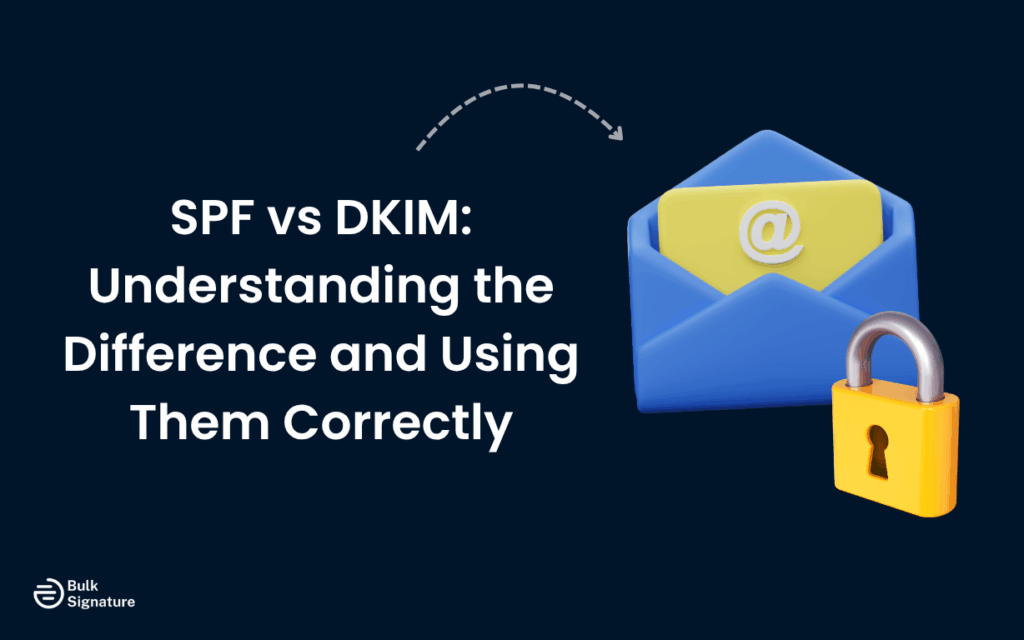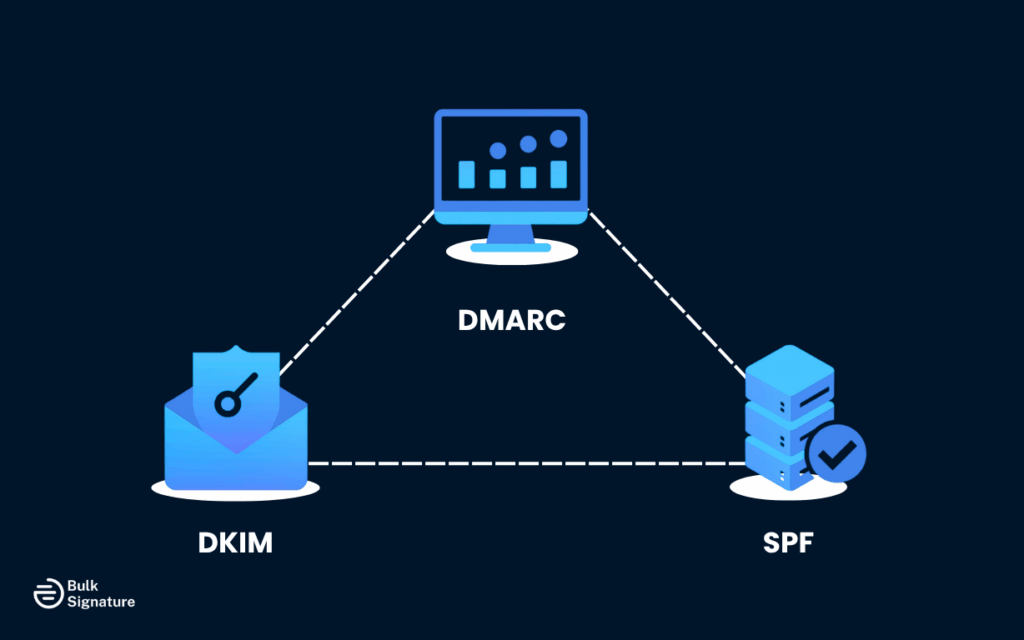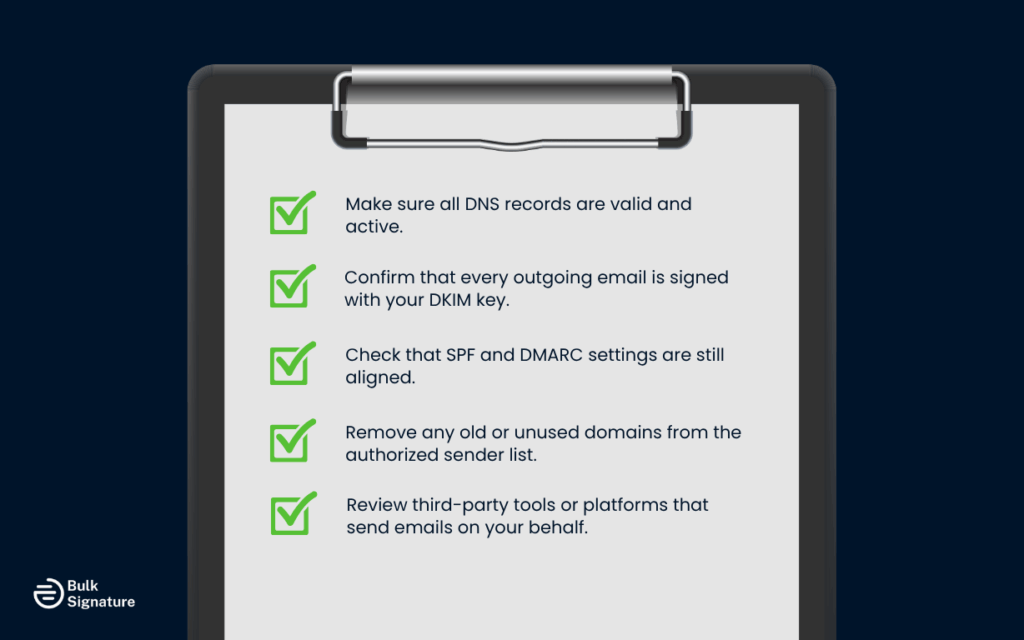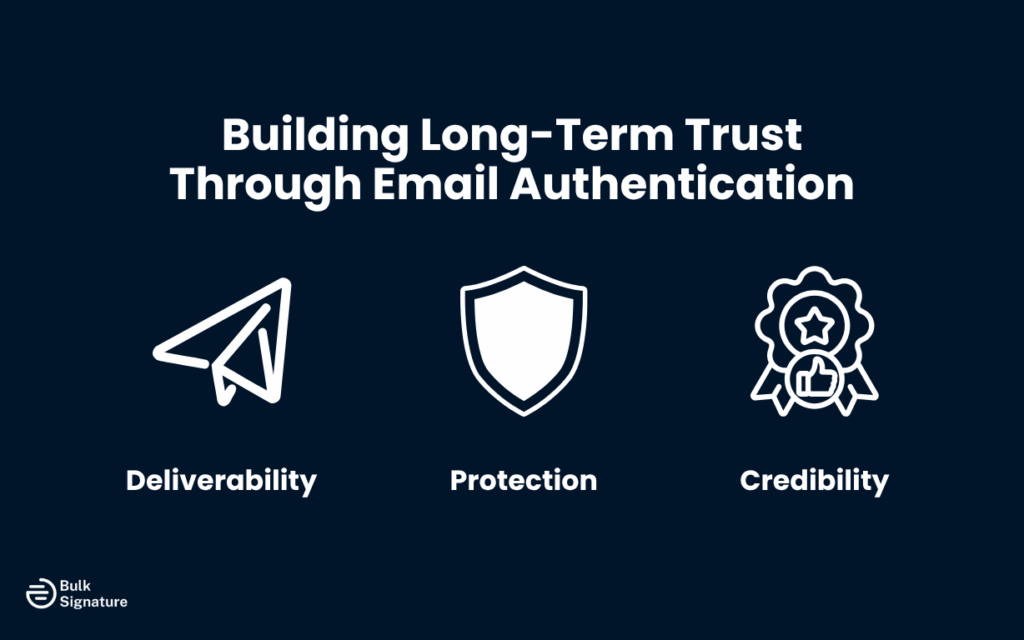
Every organization relies on email to communicate with clients, employees, and partners. But that trust is constantly being tested by cybercriminals.
One of the most common threats is a specific type of phishing attack called “email spoofing”, which is when attackers impersonate legitimate brands to trick recipients into revealing sensitive information or downloading malicious files.
This is where SPF (Sender Policy Framework) and DKIM (DomainKeys Identified Mail) come to the rescue.
If you manage IT, marketing, or compliance for an organization, having a basic understanding of how SPF and DKIM differ (and how to configure them correctly) is essential for:
- Protecting your email domain and
- Maintaining trust with your recipients.
Read on for a full breakdown of what SPF and DKIM are, how they differ, and best practices for implementation.
What Is SPF (Sender Policy Framework)?
Sender Policy Framework (SPF) is an email authentication method that verifies whether an email was sent from an authorized mail server. It works by checking if the IP address of the sending mail server is listed in the domain’s DNS record as a legitimate sender.
Here’s How It Works:
- When a message is sent, the recipient’s mail server checks the SPF record published by the sender’s domain in the Domain Name System (DNS).
- This record then tells the recipient’s server which mail servers or IP addresses are permitted to send messages on behalf of that domain.
- If the email comes from one of those authorized servers, it passes SPF authentication. If not, it fails and may be flagged as unauthenticated mail or routed to the spam folder.
In Simple Terms: SPF confirms that an email is coming from where it claims to be coming from.
Key Components of SPF Authentication
- Envelope Sender: The return-path domain used for SPF validation.
- Sending Domain’s DNS: Hosts the published SPF record in a TXT format.
- Mail Server IP Address: The actual server attempting to send the email.
- Recipient’s Mail Server: Performs the SPF check and determines whether the message passes or fails authentication.
Together, these components help the recipient’s mail server confirm whether an email should be trusted or treated as suspicious.
What Is DKIM (DomainKeys Identified Mail)?
DomainKeys Identified Mail (DKIM) is an email authentication protocol that helps verify that a message was not altered during transit. While SPF confirms the source of a message, DKIM focuses on verifying the integrity of the message content itself.
Here’s How It Works:
- When an organization sends an email, its sending mail server attaches a digital signature to the message header. This signature is created using a private key that’s stored securely on the sender’s server.
- When the recipient’s mail server checks the message, it retrieves the corresponding public key from the domain’s DNS TXT record. The mail server then uses that public key to verify the DKIM signature, making sure the message was not tampered with after it was sent.
- If the verification succeeds, the recipient can trust that the message really came from the claimed sender’s domain and that its contents are authentic. If the check fails, the message may be flagged, quarantined, or routed to the spam folder as unauthenticated mail.
In Simple Terms: DKIM acts like a tamper-proof seal for your emails. It confirms that the message wasn’t modified in transit and that it genuinely came from your domain.
Key components of DKIM authentication
A DKIM setup requires:
- A DKIM record published in your domain’s DNS (as a TXT record).
- This record contains the public key used by receiving mail servers to verify your digital signature.
Each DKIM-signed email includes a special header field that contains the DKIM signature. This signature encodes information about the message and the cryptographic hash used for validation.
A typical DKIM header includes:
- The selector and domain name used for verification.
- The cryptographic algorithm applied to generate the signature.
- The encoded digital signature created with the sender’s private key.
Together, these elements allow receiving mail servers to independently confirm that the email originated from your domain and wasn’t altered after being sent.
SPF vs DKIM: What’s the Difference?
Both SPF and DKIM help authenticate email messages, but they work in different ways and protect both the sender and the recipient from different risks. Here’s an overview of the key differences between SPF and DKIM.
SPF vs DKIM: Key Differences Explained
| Category | SPF (Sender Policy Framework) | DKIM (DomainKeys Identified Mail) |
|---|---|---|
| Authentication Method |
Checks the sending mail server’s IP address against the list of authorized servers published in the domain’s DNS TXT record. If the IP address matches, the message passes SPF validation. If not, the recipient’s system may flag or reject it. |
Uses cryptographic signatures to verify the authenticity of the message. Each message is signed with a private key, and the recipient’s server validates it using the corresponding public key in the domain’s DNS. |
| What It Confirms | Confirms who sent the message. | Confirms that the message itself is authentic and wasn’t tampered with after being sent. |
| Primary Protection | Protects against unauthorized senders and spoofed sending sources. | Protects against message manipulation and content tampering. |
| Limitations |
Forwarded emails can fail SPF checks because the forwarding server’s IP isn’t listed in the sender’s SPF record. Doesn’t protect message content (it only verifies who sent it). Can be bypassed if attackers use a different “From” address than the domain listed in SPF. |
Can break if emails are modified (for example, by mailing lists or automatic formatting tools). Needs proper key management. For example, if DKIM keys expire or aren’t set up correctly, messages may fail. Doesn’t verify the sending server and can only verify that the domain’s private key was used to sign the message. |
Why You Need Both
SPF and DKIM work best as a team:
- SPF confirms the sender’s identity through authorized servers.
- DKIM confirms the message’s authenticity through cryptographic validation.
When both are in place, they form the foundation of DMARC (Domain-based Message Authentication, Reporting, and Conformance), which is an additional layer that connects everything together. DMARC checks that the “From” address aligns with both SPF and DKIM records, giving receiving email servers and internet service providers the confidence that your emails are genuine.

The result? Your messages are more likely to reach inboxes instead of spam folders, and your brand is protected from spoofing and impersonation.
Want to learn more about improving email security? Check out our resources:
9 Best Practices for Implementing SPF and DKIM
Implementing SPF and DKIM is an ongoing process that requires technical expertise, good domain management, and regular monitoring. Here are some best practices to consider when setting up and maintaining your authentication records.
1. Publish and Validate Records Carefully
Start by publishing both an SPF record and a DKIM record in your domain’s DNS. Then, use trusted testing tools to verify that your DNS TXT records are formatted correctly. Even small typos or missing entries can cause legitimate emails to fail authentication.
- For SPF: Confirm that the SPF record includes all authorized servers and third-party senders.
- For DKIM: Confirm that each selector points to the right public key and that your mail servers are signing messages consistently.
After publishing, perform a full test send to make sure your messages pass both SPF and DKIM checks.
2. Limit SPF to Authorized Servers Only
Every SPF record should only include IP addresses and hostnames that actually send mail for your domain. Adding unnecessary “include” mechanisms or third-party entries increases complexity and risk.
Here are a few things to keep in mind:
- Avoid generic “include” statements that authorize entire networks.
- If multiple departments use different email tools, coordinate record management through IT or a centralized platform.
- Remove obsolete services or vendors promptly to maintain a clean authentication profile.
3. Rotate DKIM Keys Regularly
Your DKIM authentication relies on cryptographic keys that must remain secure and current. When they become outdated, this increases the risk of unauthorized use or key compromise.
Here are a few best practices for managing your DKIM keys:
- Rotate private/public key pairs at least once a year (every six months for high-volume domains).
- Use strong RSA or ECC encryption algorithms recommended by current standards.
- Store private keys securely on the sending mail server, not in cloud storage platforms.
- When rotating, create a new selector and update the corresponding DKIM TXT record before decommissioning the old one.
Regular key rotation preserves message integrity and keeps your digital signatures valid across all recipient mail servers.
4. Align Domains for DMARC Compatibility
SPF and DKIM work best when your domains are properly aligned for DMARC. “Alignment” simply means the domain in your “From” address matches the ones used in SPF and DKIM checks, proving that the message truly comes from your organization.
Design Guidance: show a visual of the alignment (maybe like this)
Alignment tips:
- Use consistent domain names for “From,” “Return-Path,” and “DKIM d=” values.
- Avoid sending email through subdomains that don’t share the same authentication setup.
- Publish a DMARC policy to specify how your domain should handle failed authentication attempts.
Domain alignment not only supports better deliverability, but it also prevents unauthorized systems from sending messages that appear to come from your company.
5. Document and Centralize Your Configuration
Large organizations often have multiple mail systems sending messages, such as:
- Marketing platforms
- Support desks
- Customer relationship management (CRM) platforms
- HR tools
And each of these platforms sends messages from different servers. So without proper documentation, SPF and DKIM configurations can quickly become inconsistent. To keep everything aligned, it’s worth creating a working document that includes:
- A central record of all authorized senders, including vendors and third-party tools.
- Version control for DNS TXT records and DKIM selectors.
- A change management workflow for adding or retiring sending systems.
6. Monitor Authentication Results Continuously
Once SPF and DKIM are set up, it’s important to keep an eye on how they’re performing.
Use DMARC reporting tools or your email service provider’s dashboard to monitor ongoing authentication results. Watch for recurring “fail SPF” or invalid DKIM signature errors, which could mean something is misconfigured, or that someone’s trying to send fake emails using your domain.
Regular monitoring helps you:
- Detect phishing attempts that spoof your brand.
- Identify senders that aren’t following internal authentication standards.
- Adjust DNS records before deliverability suffers.
7. Keep Your Records Simple
Long or overly complex DNS entries make authentication checks slower and harder to maintain, so try to keep your records as concise as possible.
When publishing SPF:
- Limit the number of mechanisms and modifiers.
- Combine overlapping IP ranges.
- Stay within the recommended 10 DNS lookup limit.
When publishing DKIM:
- Avoid unnecessary parameters in your DKIM TXT record.
- Use short, meaningful selectors to organize key rotation schedules.
Simplicity reduces the risk of errors and makes it much easier to troubleshoot any issues as they arise.
8. Audit Your Setup at Regular Intervals
At least twice a year, conduct a full audit of your SPF, DKIM, and DMARC configurations.

Audit reviews should check:
- That all DNS entries resolve correctly.
- That your mail servers sign every message consistently.
- That inactive domains or services are still not listed as authorized senders.
By staying proactive, you can catch any issues before they cause delivery failures or security risks. Regular audits also help you make sure that your email authentication setup evolves alongside any changes in your infrastructure, third-party vendors, or domain usage.
9. Pair With Centralized Email Management
Managing SPF and DKIM can get complicated fast when different teams (like marketing, HR, and customer service) use separate email systems to communicate with different audiences.
A centralized tool like BulkSignature can help simplify the email authentication processes by standardizing how all departments send authenticated, on-brand emails.
A few best practices to consider:
- Keep all domain and DNS changes documented and approved through IT.
- Automate SPF, DKIM, and DMARC updates across departments to avoid manual errors.
- Use role-based permissions so marketing can manage visual elements while IT handles authentication.
- Schedule quarterly reviews to make sure all third-party senders are still authorized and compliant.
- Align brand, legal, and security standards under one system to maintain consistency across teams and regions.
Building Long-Term Trust Through Email Authentication
When SPF, DKIM, and DMARC are properly configured, they serve as verifiable proof that your messages are authentic, trustworthy, and protected from tampering.

For your brand, this means:
- Higher deliverability rates, with fewer messages landing in spam folders.
- Stronger protection against phishing and domain spoofing attacks.
- Greater credibility with clients, partners, and email providers.
If your organization manages multiple domains or departments, using a centralized tool like BulkSignature is essential for keeping your authentication consistent, compliant, and aligned across every team.
Curious to see how it works? Book a free demo today.
Frequently Asked Questions About SPF, DKIM, and DMARC Records
What is a domain owner?
The domain owner is the person or organization listed as the registrant of a domain name. This entity is responsible for managing DNS settings, including SPF, DKIM, and DMARC records. Only the domain owner (or someone with DNS access) can publish or modify these authentication records.
How do I know if my domain is classified as a bulk sender?
You may be considered a bulk sender if your organization sends large volumes of email (typically over 5,000 messages per day) to external recipients such as customers, subscribers, or partners.
What are the main factors that impact email deliverability?
Email deliverability depends on several factors, including:
- Proper authentication with SPF, DKIM, and DMARC.
- Consistent sending reputation (avoiding spam complaints or high bounce rates).
- Clean, verified recipient lists that prevent sending to inactive or fake addresses.
- Engaging, relevant content that encourages engagement.
What happens if my SPF or DKIM checks fail?
If an email fails SPF or DKIM checks, it means the message couldn’t be verified as legitimate.
Depending on your DMARC policy, the receiving mail server may:
- Deliver it to the spam or junk folder.
- Quarantine it for review.
- Reject it entirely.
Common causes of failed checks include outdated DNS records, unauthorized sending services, or formatting errors. With regular monitoring and DNS audits, you can often catch these issues early before they impact deliverability.